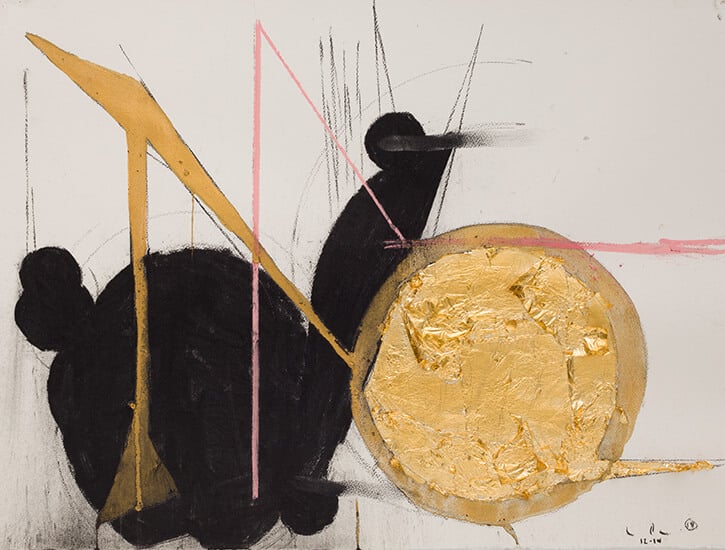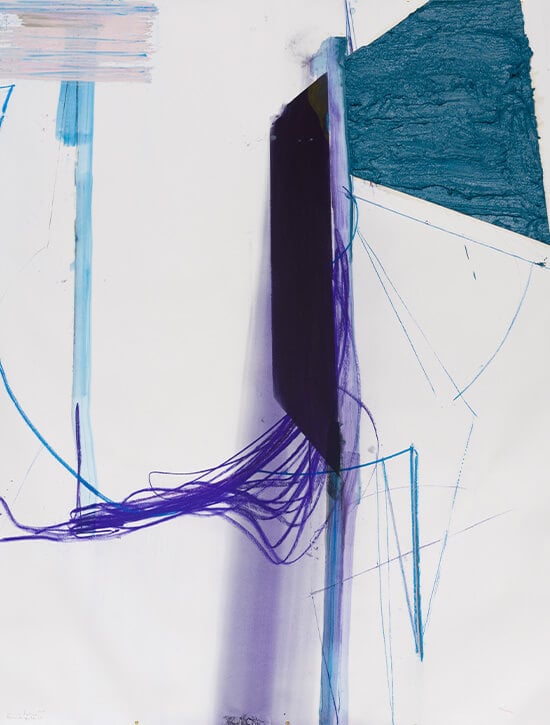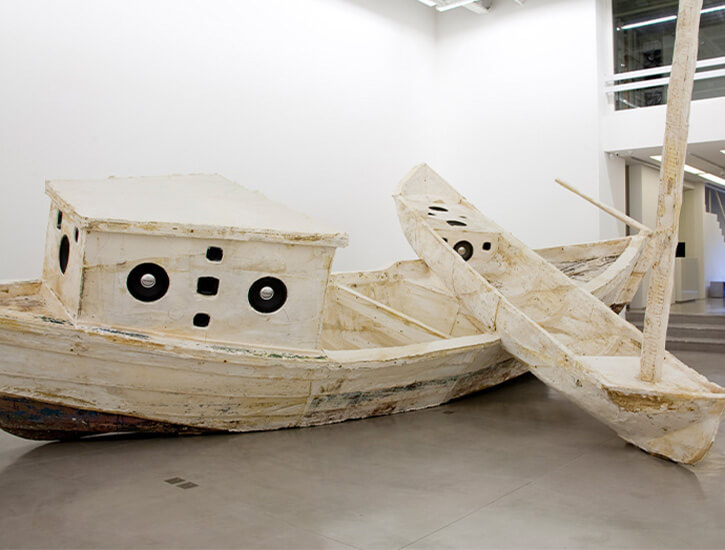Unfinished Works

Nuno Ramos is a Brazilian artist based in São Paulo. Ramos gained early recognition in the 1980s through his association with Casa 7, a group of young paulista painters who sought to move beyond the modernist aesthetics that had dominated Brazilian art in the mid-century. Largely self-trained, painters of the Casa 7 group were known for the kinetics, vibrance, and velocity of their art, which rebelled against the staid geometries of their parents’ generation, and which critics associated with the violence of a newly urbanized Brazil notorious for the chaos of its cities. Casa 7 paintings were also recognizable for their low-grade materials: industrial paints applied to inexpensive craft paper.
Often caked in layers of paint that rose in topographical relief, Ramos’s compositions began to incorporate other materials, including debris taken from São Paulo’s industrial urban landscape. In the 1990s, these compositions evolved into large-scale sculptural and multimedia installations that filled entire rooms. Now among Ramos’s most well-known works, his installations luxuriate in the layered significance and materiality of the items that compose them.
The visual poetics of Ramos’s installations have a prominent antecedent in Brazilian art: the concrete poetry printed by Brazilian avant gardists of the late 1950s and early 1960s. Honoring this inheritance by endeavoring both to extend and to surpass it, Ramos began publishing his own poetic texts, some of which form a part of his installation ensembles. For his textual works, Ramos has earned some of Brazil’s highest literary honors, including the Portugal Telecom Prize and multiple nominations for the Jabuti Prize. Meanwhile, his artistic practice has further enlarged to encompass film and video, as well as theater and performance art.
The prose works translated here are excerpted from Ramos’s most recent collection, Fooquedeu, published in 2021.
—Adam Morris
Installation
The energy central to my work comes from never being ready: from that feeling of wanting very badly to be ready, and fighting like crazy to be ready—but never achieving it. From never finishing anything. Kierkegaard has an aphorism that I like to apply to this situation: “If I were to wish for something, I would wish not for wealth or power but for the passion of possibility.” The truth is that all art, even classical art, has something of this promise. At the very least, when you think about it, art requires presentation within a genre, a counter-genre, an absence of genre, a frame or edition, a physical body, a material that defines itself somehow—a mode of presentation that restricts the horizon of the possible. Nevertheless, and no matter how perfect it is, the artwork is always at odds with its formatting, its potential, its inconclusiveness. Artists like me exacerbate this—the works literally never dry, need time to unfold, seem not to go together. The highs are too high, and the lows are too low.
In my particular case, I experience the process of installation (the first time a piece is displayed), as a vertiginous and terrifying version of that feeling of potential: it’s there in its entirety, cruel in its power but never extending guarantees. It’s capable of turning against me—or rather, of breaking, falling, and hurting someone. It might not work, or it might be bad or blow the budget. After the installation it somehow seems calm, almost balanced. And I end up relating to it, without liking it too much or too little: I feel an authentic indifference for the thing I’ve created. But while the work is still being installed, it resembles a treacherous and loving animal that shakes me awake, promising and damning, seductively drawing me in as it stabs me in the back, flashing a wink as it releases its venom. I want to free myself from it, finish it. But I also want it to remain as it is: incomplete.
Sloth
An installation requires an exaggerated number of specifications—a minute and tireless babel of prior activity. It’s the technical aspect of the profession, charging its due. The tip of a key and the slot in the head of a screw are so similar, but they never fit. Every detail seems enamored of itself and charges a steep price for its tiny part in the work’s potential—as though the chaotic power of the technical, silenced in the final product, must come to light. But nothing fits, so I waste time asking myself: Screw or nail? Allen wrench or screwdriver? L or T? Acetic or neutral? Everything holds me up and slows me down, like a sullen and irritable sloth. The installation wants to last—and every screw, when its time comes, justifies its fifteen minutes.

Caution, Wet Floor
Muscled firemen, their arms crossed, watch over us as we work, as though we’re determined suicides. We can’t go any higher than two meters on the scaffolding or the ladder. We can’t use scissors or blades. If we use any resin, we have to wear enormous, asphyxiating masks. The old disciplinary beadle of our adolescence, who lurked in the doorway to the schoolyard, interrupting cigarettes, joints, hand jobs—he spawned like a rabbit. But he doesn’t speak in the name of institutional values. He speaks in our name, or in the name of our safety. It’s a smart move because in the end he was never on our side—he was even a little afraid of us. There’s a judicialization of private life: meticulous, generic, hovering over us. The lives of others have become an economic opportunity. We can (at least in the developed countries) sue an institution that forgets to put out a little sandwich board warning of wet floors in the bathroom, or that lets us climb a ladder to a height of 2.01 meters. The firemen are there to prevent this from happening—it’s not because they care about us. It’s a circuit, a reasoning, a style that is quintessentially American, as part of which money cuts through the private lives of people in other countries at unimaginable levels. Curiously, the expression “shit happens” comes from America too. But this shit, the inevitable accident—it hasn’t happened and never will, at least not in the sterilized perimeter that my work and I occupy. Here it’s as though there were no accidents. Accident: a causal system is interrupted by a new causal chain, superimposed upon the previous (Hume: “The falling of a pebble may, for aught we know, extinguish the sun.”) that’s both arbitrary (and thus its accidental appearance) and necessary (and for that reason seems fatal). An I-don’t-know-what—and therefore something divine—that we go to great lengths to be rid of, shifting the responsibility onto someone else. The stone fell and somebody’s head was in the way. That bad luck, that destiny—it was his time. No: today it’s always somebody’s fault and somebody has to pay for it.
Witchcraft
Sometimes it’s the dead man himself who pays. He smoked, drank, was too sedentary, worked too much or too little, didn’t play sports, stopped taking his meds, was too stressed. If he’s dead, it’s his own fault—he should’ve tried harder not to die. Today no one is forgiven, not even at the hour of death. Dying is for losers.
Likewise, for the Zande people, as recounted in E.E. Evans-Pritchard’s famous book[1], there is no such thing as an accident. The person to blame isn’t the dead man, but rather the witch. Every accident is the result of a spell and demands a long series of counter-spells to begin a new causal chain, one overseen by humans rather than nature. The Zande have strange techniques for discovering the witches responsible for these “accidents.” “In the bodies of the dead, a witchcraft-substance is discovered through an opening in the abdomen. . . . An autopsy is conducted in public, at the edge of the grave. They detect its presence by the form of the intestines that protrude from the abdomen.”

Good Work, Bad Work
So this is it, then—the artist’s life? Being surrounded by people and having the right to certain arbitrariness of self? It should be the opposite: the artist is the one who transfers (to use the psychoanalytic term) absolutely everything, to the point of having no return or identification with the work they set in motion. If it’s well done, that thing that’s made with hands and empty pockets will take its leave. But when it’s poorly done, it remains poised like a butterfly on the shoulder of its author. Bad work is always visible, palpable, recognizable. The other kind isn’t. No one can really answer for it. Bad work is just there, striking up a conversation with everyone, making speeches—the artist is its ventriloquist. The other kind finds a diagonal, empties the room and time itself.
In this sense, it seems right to feel commiseration and not repugnance for a bad work of art, for everything in it that resembles the common and downtrodden. That poet who tries to write about the meaning of life and shares his verse at a New Year’s party should inspire our respect and sympathy. The problem is the great and obvious injustice of the physical permanence of bad art—the possibility of it lasting longer than anything contemporary to it (the public that saw it birthed, as well as the objects of its era)—because bad art is so bound up with its surroundings that it seems right they should die together. That’s why, when you think about it, maybe it isn’t cruel to tear it up or burn it. Because it isn’t fair that in its physical and corporeal enclosure, without wing or flight, it could manage to survive the people and the walls that were its neighbors.
Max Brod
I don’t know if suicide is the only serious philosophical problem. I think that’s inflated logic. You can’t compare suicides. In the artistic domain, Camus’s pronouncement really only works for the suicide of a Van Gogh or a Seneca—the kind of suicide that flows back across the work of the artist who killed himself, reconfiguring their meaning. Take Deleuze, for example, who threw himself from his apartment window because he could barely breathe anymore. Suicide was certainly not the only serious philosophical problem for Deleuze. His work does not introject the meaning of his death.
But suicide’s simile in the cultural domain—burning everything one has written—seems incredibly cohesive and powerful. You might say that it’s “the only serious literary question.” Voluntarily losing all one’s work puts the artist on the plane of . . . what exactly? A martyr? A pharaoh buried with his treasure? Narcissus dictating to the world what does and does not make sense? A Buddhist saint stripped of his feats?
Mostly likely, we’ve lost some Kafkas, who burned everything when they finished—artists we’ll never even hear about because they never had a Max Brod to save them. Pessoa’s trunk, Pascal’s liasses, and Emily Dickinson’s papers were all candidates. But each was saved.
Salt
An actor, standing before a mountain of salt, uses a shovel to bury books that a second actor brings from a shelf positioned on the other side of the stage. The whole thing is just that, with the two actors talking and reading selections from the books as they go. One of them crosses the stage and sets down another book that the other reads aloud and then covers with tiny mountains of salt.
[1] Witchcraft, Oracles and Magic among the Azande (1937).